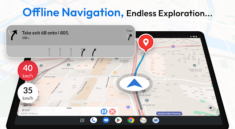
Airports are gateways to the world, but they can also be a source of stress, delays, confusion, and frustration—especially for those unfamiliar with the process or traveling during peak hours. From long security lines to confusing signage, unexpected baggage rules, and missed connections, navigating an airport can feel overwhelming. But it doesn’t have to be.
With the right preparation, tools, and mindset, you can glide through even the busiest terminals with confidence and efficiency. Whether you’re a frequent flyer or an occasional traveler, this comprehensive guide will help you master airport navigation and save valuable time at every stage of your journey.
1. Before You Leave: Pre-Trip Preparation
A. Check Your Documents
- Valid Passport and Visa: Make sure your passport is valid for at least six months beyond your return date. Check visa requirements well in advance.
- Travel Insurance: Have a copy of your insurance details and emergency contact numbers.
- Boarding Pass: Check in online and download your boarding pass to your phone, or print a copy just in case.
B. Use Travel Apps for Flight Tracking
- FlightAware, TripIt, or App in the Air allow you to track flight statuses, gate changes, delays, and more in real time.
- Sign up for airline alerts via SMS or app notifications to stay updated on any last-minute changes.
C. Know the Airport Layout
- Visit the official airport website or use apps like LoungeBuddy or GateGuru to review maps, terminal locations, dining options, lounges, and amenities.
2. Packing Smart: Avoid Airport Hassles
A. Follow TSA and Airline Rules
- Liquids Limit: Carry liquids in 100ml (3.4 oz) containers and place them in a clear, zip-top bag.
- No Prohibited Items: Check the TSA or equivalent authority’s list of restricted items.
B. Organize for Efficiency
- Electronics Easily Accessible: Keep laptops, tablets, and power banks near the top of your bag for quick access at security checkpoints.
- Separate Essentials: Use packing cubes and small pouches for documents, chargers, medication, and valuables.
- Dress Strategically: Avoid belts, boots, and excessive jewelry that may slow you down at security.
C. Invest in a Good Carry-On
- Use a carry-on with 360-degree spinner wheels for maneuverability.
- Look for compartments that allow quick access to passports, devices, and boarding passes.
3. Getting to the Airport: Time Is Everything
A. Arrive Early—But Not Too Early
- Domestic flights: Arrive at least 2 hours before departure.
- International flights: Arrive 3 hours ahead of time.
- Check your airline’s recommendations, especially during holidays or peak seasons.
B. Consider Transportation Options
- Rideshare apps (Uber, Lyft, Bolt) are often more reliable than public transport when you’re in a hurry.
- Airport shuttles or express trains can save you from traffic congestion.
- Park Smart: Use off-site long-term parking apps like SpotHero or ParkWhiz to find cheaper and faster options.
4. Check-In and Baggage Drop: Be First, Not Fast
A. Online Check-In Is Your Friend
- Most airlines open online check-in 24–48 hours before departure. This can help you:
- Choose better seats
- Skip long lines
- Avoid airport kiosks
B. Use Self-Service Kiosks
- Many airports have automated check-in kiosks and bag-drop machines, which are faster than standing in full-service lines.
C. Weigh Your Bags in Advance
- Avoid costly overweight baggage fees by checking your bag’s weight with a portable luggage scale.
- Know the baggage limits for your airline: low-cost carriers have much stricter policies.
5. Security Checkpoint: Breeze Through With Ease
A. Use Trusted Traveler Programs
- Enroll in:
- TSA PreCheck (USA): Expedited security screening
- Global Entry (USA): Faster customs clearance
- CLEAR: Uses biometrics to skip ID checks
- eGates and Smart Gates (UK, EU, Asia): Allow biometric passport holders to pass faster
B. Prepare Ahead in Line
- Remove your laptop and liquids before reaching the bins.
- Take off shoes, jackets, and belts (unless enrolled in PreCheck or similar programs).
- Stay calm and focused. Don’t fumble with items at the last minute.
6. Gate Navigation and Boarding: Don’t Get Left Behind
A. Monitor Your Gate
- Flight gates can change last minute. Keep an eye on:
- Flight info boards
- Airline app notifications
- Airport PA announcements
B. Stay Close—But Not Too Close
- Once you know your gate:
- Find nearby seats, charging stations, or cafes.
- Avoid crowding the gate area until your boarding group is called.
C. Know Boarding Groups and Priority
- Understand how your airline boards passengers—by zones, groups, or seat rows.
- If you’re eligible for priority boarding (business class, elite status, families), listen for special announcements.
7. In Transit: Layovers And International Airports
A. Short Layovers: Speed is Key
- Choose flights with at least 1 hour for domestic layovers and 2–3 hours for international transfers.
- Be aware of:
- Terminal changes
- Passport control
- Security re-checks
B. Long Layovers: Use the Time Wisely
- Stretch, eat, work, or nap. Some tips:
- Airport lounges offer Wi-Fi, showers, food, and quiet areas.
- Use apps like Priority Pass, LoungeBuddy, or DragonPass to access lounges without elite status.
- Many airports now have sleep pods, yoga rooms, and nap areas.
8. Customs and Immigration: Smart Strategies
A. Have Documents Ready
- Passport, visa, customs form, and travel itinerary should be accessible before reaching the counter.
- Be prepared to answer questions: where you’re staying, length of stay, and return plans.
B. Use E-Gates Where Available
- Countries like Singapore, Australia, Germany, and the UK offer automated passport control for eligible travelers.
C. Declare Items Honestly
- Don’t risk fines. If you’re unsure, declare food, electronics, cash over $10,000, and restricted goods.
9. Baggage Claim: Save Time and Headaches
A. Identify Your Bag Easily
- Use bright tags, colorful straps, or stickers to make your luggage easy to spot.
- Add a tracking device like Apple AirTag or Tile inside your suitcase.
B. Know What to Do If It’s Lost
- Report lost luggage immediately at the baggage service desk.
- Keep your baggage claim tag until you receive your bags.
- Most airlines deliver lost bags to your hotel or home once found.
10. Exit and Ground Transportation: Finish Strong
A. Avoid Taxi Scams
- Use official taxi lines, pre-booked services, or reputable ride-share apps.
- Avoid anyone approaching you offering unsolicited rides.
B. Use Local Transit Apps
- Rome2Rio, Moovit, and Citymapper can guide you through local buses, trains, and metro systems efficiently.
C. Currency and SIM Cards
- Avoid poor exchange rates at airport kiosks. Withdraw small amounts of local currency from ATM machines.
- Get a local SIM card or use eSIM apps like Airalo for better connectivity at lower rates.
11. Extra Tips: Frequent Flyer Habits
A. Always Carry a Pen
- Useful for customs forms or declarations in countries that still use paper.
B. Hydrate and Stretch
- Bring a reusable water bottle and refill it after security.
- Walk and stretch during layovers to avoid stiffness or jet lag.
C. Be Polite and Prepared
- Courteous travelers often get help faster.
- Have all relevant information ready when talking to airport staff.
Conclusion: Travel Like a Pro, Every Time
Navigating airports doesn’t have to be stressful or time-consuming. By preparing in advance, packing smart, staying informed, and using the right tools and habits, you can move through any airport—no matter how busy or unfamiliar—with confidence and ease.
Whether you’re flying for business, vacation, or adventure, mastering airport navigation helps you save time, reduce stress, and start your journey on the right foot. With a calm approach and a few professional habits, you’ll be soaring above airport chaos in no time.




